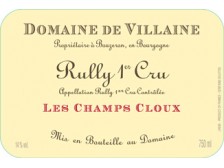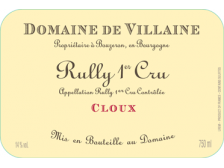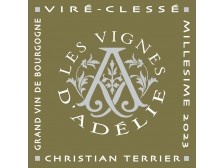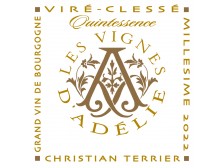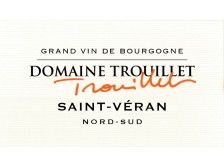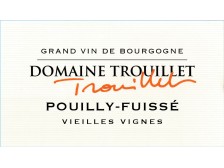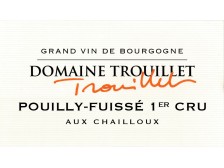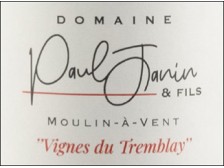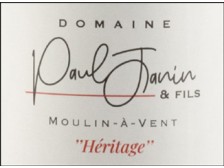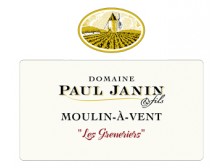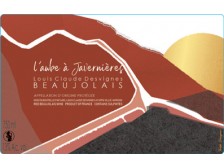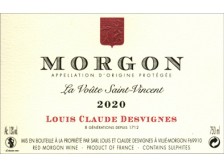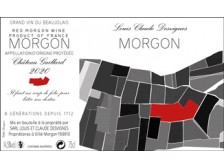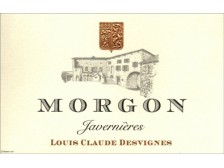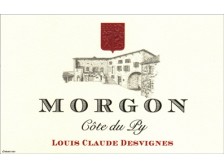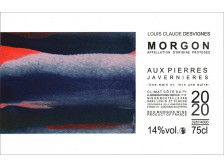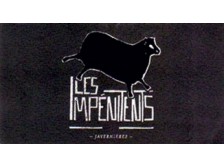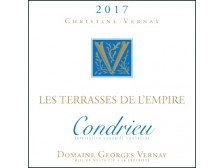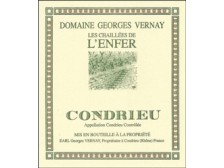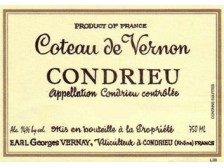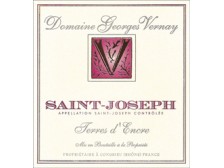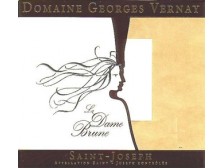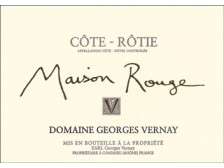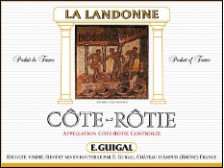Catalog
-
Aubert de Villaine, the emblematic co-owner and manager of La Romanée-Conti, lives and works in Bouzeron, the first village south of the Côte de Beaune, on his Domaine acquired in 1971. Assisted since 2003 by his nephew Pierre de Benoist, he practises the same high-flying viticulture as at La Romanée-Conti, combining tradition, openness, purity, rigour and organic cultivation (since 1986).
Domaine rated one star in the Revue du Vin de France guide, and named one of the top 5 producers of 2021 by the magazine Bourgogne Aujourd'hui.The 2021 vintage in the press:
La Revue du Vin de France (Guide 2025): 93/100 “More structured and full-bodied, Les Champs Cloux is also the most poised and accessible of the reds presented, with its mellow scope, silky tannins, freshness and finesse.”
More- To keep or to drink:
- Wait 3 to 5 years
- Apogée:
- 2028-2042
-
Aubert de Villaine, the emblematic co-owner and manager of La Romanée-Conti, lives and works in Bouzeron, the first village south of the Côte de Beaune, on his Domaine acquired in 1971. Assisted since 2003 by his nephew Pierre de Benoist, he practises the same high-flying viticulture as at La Romanée-Conti, combining tradition, openness, purity, rigour and organic cultivation (since 1986).
Domaine rated one star in the Revue du Vin de France guide, and named one of the top 5 producers of 2021 by the magazine Bourgogne Aujourd'hui.The 2022 vintage in the press:
Bourgogne Aujourd'hui (August 2023): 17/20 “Black fruit nose, dominated by blackcurrant. Full-bodied on the palate, with firm but ... tannins”.
More- To keep or to drink:
- Wait 1 to 2 years
- Apogée:
- 2026-2038
-
Aubert de Villaine, the emblematic co-owner and manager of La Romanée-Conti, lives and works in Bouzeron, the first village south of the Côte de Beaune, on his Domaine acquired in 1971. Assisted since 2003 by his nephew Pierre de Benoist, he practises the same high-flying viticulture as at La Romanée-Conti, combining tradition, openness, purity, rigour and organic cultivation (since 1986).
Domaine rated one star in the Revue du Vin de France guide, and named one of the top 5 producers of 2021 by the magazine Bourgogne Aujourd'hui.The 2021 vintage in the press:
La Revue du Vin de France (Guide 2025): 92/100 “Powdery, unctuous substance in Les Cloux, perfumed and lifted by a note of citrus peel”.
More- To keep or to drink:
- Wait 3 to 5 years
- Apogée:
- 2028-2042
-
The grandson and son of a winegrower, Christian Terrier established his estate in Clessé in 2009, purchasing 16 hectares of beautiful “cray” terroir (white pebble limestone) that is so favourable for Chardonnay. Together with his daughter Adélie, they favour natural methods (ploughing, organic treatments, etc.) and traditional winemaking techniques (slow fermentation with indigenous yeasts, light filtration, etc.). Their wines are delicious and long-lasting, with an immediate, invigorating and authentic charm.
Made from vines aged 50 years and over, the ‘petit’ Viré-Clessé village is a dynamic white wine, endowed with "a fruity freshness echoed by a very lively, long and balanced palate" according to the Guide Hachette 2025.
More- To keep or to drink:
- Ready to drink
- Apogée:
- 2025-2029
-
The grandson and son of a winegrower, Christian Terrier established his estate in Clessé in 2009, purchasing 16 hectares of beautiful “cray” terroir (white pebble limestone) that is so favourable for Chardonnay. Together with his daughter Adélie, they favour natural methods (ploughing, organic treatments, etc.) and traditional winemaking techniques (slow fermentation with indigenous yeasts, light filtration, etc.). Their wines are delicious and long-lasting, with an immediate, invigorating and authentic charm.
Quintessence, aged for 12 months in oak barrels, has extra body and aromas (lemon, quince and honeysuckle), with an elegant hint of acidity on the finish.
The 2022 vintage in the press:
La Revue du Vin de France (June 2025): 90/100 "Well-ripened, spicy flesh, fairly robust style, solid texture. Needs to be left to age a little longer."
More- To keep or to drink:
- Ready to drink
- Apogée:
- 2025-2032
-
C'est William Trouillet (5ème génération) qui gère aujourd'hui le domaine familial de 19,5 ha, réparti sur les meilleures appellations du mâconnais : Mâcon-Solutré, Pouilly-Fuissé, Pouilly Loché, Pouilly Vinzelles et Saint-Véran. Avec comme ligne directrice la volonté de produire de grands blancs à la minéralité affirmée mais toujours lovés dans une chair ample et dense. Des vins généreux et immédiatement séducteurs, au rapport qualité/prix/plaisir garanti !
Cette cuvée s'appelle Nord-Sud car provenant de deux parcelles, une au nord et l'autre au sud de Saint-Véran.
The 2023 vintage in the press:
Bourgogne Aujourd'hui (August 2024): 16/20 “Fresh, lemony nose with a hint of white peach. Juicy on the palate, with fruit and substance. Beautiful balance.”
More- To keep or to drink:
- Ready to drink
- Apogée:
- 2024-2030
-
William Trouillet (5th generation) now manages the 19.5 hectare family estate, spread over the best Mâconnais appellations: Mâcon-Solutré, Pouilly-Fuissé, Pouilly Loché, Pouilly Vinzelles and Saint-Véran. Our guiding principle is to produce great whites with a pronounced minerality, but always with a full, dense body. Generous, immediately seductive wines, with guaranteed value for money and pleasure!
The Vieilles Vignes cuvée is a blend of vines aged between 40 and 60 years on clay-limestone soils (Solutré-Pouilly).
More- To keep or to drink:
- Ready to drink
- Apogée:
- 2025-2033
-
William Trouillet (5th generation) now manages the 19.5 hectare family estate, spread over the best Mâconnais appellations: Mâcon-Solutré, Pouilly-Fuissé, Pouilly Loché, Pouilly Vinzelles and Saint-Véran. Our guiding principle is to produce great whites with a pronounced minerality, but always with a full, dense body. Generous, immediately seductive wines, with guaranteed value for money and pleasure!
The Vieilles Vignes cuvée is a blend of vines aged between 40 and 60 years on clay-limestone soils (Solutré-Pouilly).
The 2022 vintage in the press:
Bourgogne Aujourd'hui (September 2023): 15/20
More- To keep or to drink:
- Ready to drink
- Apogée:
- 2025-2033
-
William Trouillet (5th generation) now manages the 19.5 hectare family estate, spread over the best Mâconnais appellations: Mâcon-Solutré, Pouilly-Fuissé, Pouilly Loché, Pouilly Vinzelles and Saint-Véran. Our guiding principle is to produce great whites with a pronounced minerality, but always with a full, dense body. Generous, immediately seductive wines, with guaranteed value for money and pleasure!
The 1er cru Aux Chailloux is the estate's flagship cuvée, their fattest and richest wine because it comes from deep marl and clay soils.
The 2022 vintage in the press:
Bourgogne Aujourd'hui (September 2023): 15.5/20 “Fruity, spicy aromas, coated with fine woody-torrefied notes. Full-bodied, concentrated, ample and delicious on the palate”.
More- To keep or to drink:
- Ready to drink
- Apogée:
- 2025-2035
-
An emblematic estate of the Moulin à Vent appellation known in Beaujolais for being the one that, by the complexity and distinction of its wines, competes best with the pinot noir of the Côte d'Or. With 8 hectares of the best Moulin à Vent plots and very old vines (80 to 100 years old for the Heritage), Domaine Janin produces ambitious, structured, dense wines, at the crossroads between tradition and modernity, with excellent ageing potential without being too austere in their youth.
Rated two stars in the Revue du Vin de France guide.
Well done! A double success for Éric Janin, elected one of the winemakers to watch in 2024 by the Revue du Vin de France and named "domaine coup de cœur" by the magazine Bourgogne Aujourd'hui in April 2023.
Les Vignes du Tremblay, a blend of several lieux-dits, is a cuvée for immediate pleasure, quickly accessible.
The 2023 vintage in the press:
La Revue du Vin de France (Guide 2026) : 94/100 "Les Vignes du Tremblay, meanwhile, is defined by its mineral depth and rounded off by subtle roasted notes. Great ageing potential can be expected."
More- To keep or to drink:
- Wait 1 to 2 years
- Apogée:
- 2026-2033
- Organic certification:
- 2024
-
An emblematic estate of the Moulin à Vent appellation known in Beaujolais for being the one that, by the complexity and distinction of its wines, competes best with the pinot noir of the Côte d'Or. With 8 hectares of the best Moulin à Vent plots and very old vines (80 to 100 years old for the Heritage), Domaine Janin produces ambitious, structured, dense wines, at the crossroads between tradition and modernity, with excellent ageing potential without being too austere in their youth.
Rated two stars in the Revue du Vin de France guide.
Well done! A double success for Éric Janin, elected one of the winemakers to watch in 2024 by the Revue du Vin de France and named "domaine coup de cœur" by the magazine Bourgogne Aujourd'hui in April 2023.
Héritage is the domaine's cuvée de garde, made from 80 to 100-year-old vines grown in low goblets on weathered granite soil.
More- To keep or to drink:
- Ready to drink
- Apogée:
- 2027-2035
- Organic certification:
- 2024
-
An emblematic estate in the Moulin à Vent appellation, known for the complexity and distinction of its wines, which best rival the Pinot Noirs of the Côte d'Or. With 8 hectares of the best plots and very old vines (80 to 100 years old for the Héritage), Domaine Janin makes ambitious, structured, dense wines, at the crossroads between tradition and modernity, with excellent ageing potential without being too austere when young.
Rated two stars in the Revue du Vin de France guide.
Well done! A double success for Éric Janin, elected one of the winemakers to watch in 2024 by the Revue du Vin de France and named "domaine coup de cœur" by the magazine Bourgogne Aujourd'hui in April 2023.
The rare cuvée parcellaire Les Greneriers, produced only in the best years, comes from the historic heart of the estate: century-old vines, deep granite soil and tiny yields (20hl/ha).
The 2022 vintage in the press:
Bourgogne Aujourd'hui (November 2024): 18/20 “Aromas still discreet, but rich and above all refined, precise, with ripe black fruits, floral notes... Concentrated, juicy, greedy, elegant palate, with velvety tannins, generous fruit, superb persistence and lots of class.”
Bettane + Desseauve (Guide 2026) : 93/100
More- To keep or to drink:
- Wait 1 to 2 years
- Apogée:
- 2025-2035
- Organic certification:
- 2024
-
An emblematic estate in the Moulin à Vent appellation, known for the complexity and distinction of its wines, which best rival the Pinot Noirs of the Côte d'Or. With 8 hectares of the best plots and very old vines (80 to 100 years old for the Héritage), Domaine Janin makes ambitious, structured, dense wines, at the crossroads between tradition and modernity, with excellent ageing potential without being too austere when young.
Rated two stars in the Revue du Vin de France guide.
Well done! A double success for Éric Janin, elected one of the winemakers to watch in 2024 by the Revue du Vin de France and named "domaine coup de cœur" by the magazine Bourgogne Aujourd'hui in April 2023.
The rare cuvée parcellaire Les Greneriers, produced only in the best years, comes from the historic heart of the estate: century-old vines, deep granite soil and tiny yields (20hl/ha).
More- To keep or to drink:
- Ready to drink
- Apogée:
- 2025-2035
- Organic certification:
- 2024
-
The philosophy of Domaine Desvignes is simple: respect tradition. Hence a culture without weedkillers, "old-fashioned" vinification and rather long maturations in cement vats only. The result is great structured morgons with a subtle and accomplished structure, and a keeping capacity worthy of the great Burgundies (10 years and more).
Rated three stars in the Revue du Vin de France guide.L'Aube à Javernières is a perfect entry-level Desvignes on a parcel of 0.84 ha on the edge of the Morgon appellation (Côte du Py), a frank Beaujolais, easy to drink but with a very present background.
The 2023 vintage in the press:
Bourgogne Aujourd'hui (November 2024): 16.5/20 “Vinified with 50% de-stemmed grapes, this cuvée reveals an intense color and a fine, fresh, fruity, spicy nose.... The wine is dense, greedy, coated and silky, with fine balance and finesse”.
Vinous (N. Martin - March 2025): 85-87/100 "The 2023 Beaujolais L'Aube à Javernières, which is close to Côte du Py, has an expressive red cherry-and-strawberry-scented bouquet that becomes more floral with aeration. The palate is medium-bodied with crunchy red fruit, quite strict and linear with straighforward peppery/sour cherry finish. Fine."
More- To keep or to drink:
- Ready to drink
- Apogée:
- 2024-2028
- Organic certification:
- 2023
-
The philosophy of Domaine Desvignes is simple: respect tradition. Hence a culture without weedkillers, "old-fashioned" vinification and rather long maturations in cement vats only. The result is great structured morgons with a subtle and accomplished structure, and a keeping capacity worthy of the great Burgundies (10 years and more).
Rated three stars in the Revue du Vin de France guide.The estate's flagship, La Voûte Saint-Vincent is built on tender, greedy fruitiness, without lacking in substance.
The 2023 vintage in the press:
La Revue du Vin de France (2026 Guide): 93/100 "This appealing style reveals a distinctive burst of fruit and a certain panache."
More- To keep or to drink:
- Ready to drink
- Apogée:
- 2024-2029
- Organic certification:
- 2023
-
The philosophy of Domaine Desvignes is simple: respect tradition. Hence a culture without weedkillers, "old-fashioned" vinification and rather long maturations in cement vats only. The result is great structured morgons with a subtle and accomplished structure, and a keeping capacity worthy of the great Burgundies (10 years and more).
Rated three stars in the Revue du Vin de France guide.The estate's flagship, La Voûte Saint-Vincent is built on tender, greedy fruitiness, without lacking in substance.
The 2022 vintage in the press :
Vinous (N. Martin - March 2023): 89/100 "A mix from just under 5-hectares of various plots in the north of the appellation, the 2022 Morgon La Voûte Saint-Vincent, has a perfumed nose of red cherries, kirsch and tangerine scents. The palate is medium-bodied, harmonious and quite fleshy with very supple tannins and, gentle grip. Mulberry and black cherries mix with white pepper towards the finish."
More- To keep or to drink:
- Ready to drink
- Apogée:
- 2024-2029
- Organic certification:
- 2023
-
The philosophy of Domaine Desvignes is simple: respect tradition. Hence a culture without weedkillers, "old-fashioned" vinification and rather long maturations in cement vats only. The result is great structured morgons with a subtle and accomplished structure, and a keeping capacity worthy of the great Burgundies (10 years and more).
Rated three stars in the Revue du Vin de France guide.The Château Gaillard cuvée, made from very old vines (80 years old), plays the density card.
The 2023 vintage in the press:
La Revue du Vin de France (2026 Guide): 93/100 "Château-Gaillard has reached a new milestone, offering more precise and indulgent black fruit."
Bourgogne Aujourd'hui (November 2024): 17/20 “Intense color, fine, soft aromas of black fruits and violets... Sweet, greedy fruit on the palate, dense, velvety, long, with obvious ageing potential.”
Vinous (N.Martin - April 2024): 92-94/100 “The 2023 Morgon Château-Gaillard comes from vines planted in 1920 and 1952. This is very cohesive on the nose, with more black fruit than the Montpelain and just a subtle reduction at play. The palate is medium-bodied with fine-boned tannins, very focused, gaining density toward the finish with a dash of black pepper that prolongs lenght. Outstanding."
More- To keep or to drink:
- Ready to drink
- Apogée:
- 2025-2031
- Organic certification:
- 2023
-
The philosophy of Domaine Desvignes is simple: respect tradition. Hence a culture without weedkillers, "old-fashioned" vinification and rather long maturations in cement vats only. The result is great structured morgons with a subtle and accomplished structure, and a keeping capacity worthy of the great Burgundies (10 years and more).
Rated three stars in the Revue du Vin de France guide.The Château Gaillard cuvée, made from very old vines (80 years old), plays the density card.
The 2022 vintage in the press:
La Revue du Vin de France (Guide 2025): 94/100 “Château-Gaillard is gaining in depth, its fruit is more open. Its delicate mouthfeel makes it already accessible.”
Bourgogne Aujourd'hui (August 2024): 16.5/20 “The estate cultivates 1.03 hectares of 80-year-old vines in the lieu-dit. Intense, brilliant color. Expressive, precise aromas of cherries, raspberries, blackberries...Dense, delicate, elegant palate, with “sweet”, fleshy fruit, good balance and potential.”
Vinous (N. Martin - March 2023): 92/100 “The 2022 Morgon Château Gaillard is named after the lieu-dit (there is no château there), a single hectare on sandy soils, aged in 30-hectolitre concrete eggs. Redcurrant, raspberry coulis and blueberry scents blossom on the nose - very pure and well defined. The palate is medium-bodied with grainy tannins and touches of graphite. there's firm grip with a lot of substance on the finish. This should age supremely well.”
More- To keep or to drink:
- Ready to drink
- Apogée:
- 2025-2031
- Organic certification:
- 2023
-
The philosophy of Domaine Desvignes is simple: respect tradition. Hence a culture without weedkillers, "old-fashioned" vinification and rather long maturations in cement vats only. The result is great structured morgons with a subtle and accomplished structure, and a keeping capacity worthy of the great Burgundies (10 years and more).
Rated three stars in the Revue du Vin de France guide.The estate's four greatest cuvées (Javernières, Côte du Py, Javernières Aux Pierres and the most famous, Les Impénitents) all come from the Côte du Py climat. These Morgons combine the richness of Gamay with exceptional depth and length. Fleshy wines, made for laying down.
The 2023 vintage in the press:
La Revue du Vin de France (2026 Guide): 96/100 "Javernières is still austere, tight and virile, but its coolness makes it delicious. In."
Vinous (N.Martin - April 2024): 90-92/100 “The 2023 Morgon Javernières has a deep and rounded nose, black cherries mixing with wild strawberries and oyster shells. The palate is medium-bodied with sapid, black-olive-tinged dark berry fruit, easing off toward the slightly confit-like finish. This is such a cemely Morgon that it will be nearly impossible to resist its youth.”
More- To keep or to drink:
- Wait 1 to 2 years
- Apogée:
- 2026-2035
- Organic certification:
- 2023
-
The philosophy of Domaine Desvignes is simple: respect tradition. Hence a culture without weedkillers, "old-fashioned" vinification and rather long maturations in cement vats only. The result is great structured morgons with a subtle and accomplished structure, and a keeping capacity worthy of the great Burgundies (10 years and more).
Rated three stars in the Revue du Vin de France guide.The estate's four greatest cuvées (Javernières, Côte du Py, Javernières Aux Pierres and the most famous, Les Impénitents) all come from the Côte du Py climat. These Morgons combine the richness of Gamay with exceptional depth and length. Fleshy wines, made for laying down.
The 2023 vintage in the press:
La Revue du Vin de France (2026 Guide): 94/100 "Côte du Py is dense for the locality, but it has good ageing potential."
Vinous (N. Martin - March 2025): 92/100 "The 2023 Morgon Côte du Py was bottled in July 2024. It has a lovely bouquet, very precise and complex with black fruit, truffle and light sea cave aromas. The palate is medium-bodied with grainy tannins, fine structure and backbone. The sustained finish is probably just beginning to close down for a while. Excellent."
Bourgogne Aujourd'hui (November 2024): 18/20 “Made from 80-year-old vines, with 95% of the grapes vinified whole and aged for 9 months in 30-hl concrete eggs (as for the Les Pierres cuvée), this top-flight Morgon has an intense color, a rich, precise nose of ripe black fruits and spices... Dense, compact, harmonious, long and racy on the palate, perfect for laying down."
"More- To keep or to drink:
- Wait 3 to 5 years
- Apogée:
- 2028-2041
- Organic certification:
- 2023
-
The philosophy of Domaine Desvignes is simple: respect tradition. Hence a culture without weedkillers, "old-fashioned" vinification and rather long maturations in cement vats only. The result is great structured morgons with a subtle and accomplished structure, and a keeping capacity worthy of the great Burgundies (10 years and more).
Rated three stars in the Revue du Vin de France guide.The estate's four greatest cuvées (Javernières, Côte du Py, Javernières Aux Pierres and the most famous, Les Impénitents) all come from the Côte du Py climat. These Morgons combine the richness of Gamay with exceptional depth and length. Fleshy wines, made for laying down.
The 2023 vintage in the press:
La Revue du Vin de France (2026 Guide): 93/100
Bourgogne Aujourd'hui (November 2024): 17.5/20 “Intense, brilliant purplish color. Aromas of black fruit, violets, spices...Rich, full, fleshy, juicy mouthfeel, with racy, velvety tannins, generous, greedy fruit and a fresh, elegant finish.”
Vinous (N.Martin - April 2024): 91-93/100 “The 2023 Morgon Aux Pierres Javernières comes from vines planted in 1931 and aged in concrete eggs. This is slightly more opulent and candied on the nose than the Côte du Py, perhaps without the same sophisitication. The palate is medium-bodied with fine-boned tannins, a little earthier in style, very well-balanced with an almost flinty finish. Excellent.”
More- To keep or to drink:
- Wait 3 to 5 years
- Apogée:
- 2027-2040
- Organic certification:
- 2023
-
The philosophy of Domaine Desvignes is simple: respect tradition. Hence a culture without weedkillers, "old-fashioned" vinification and rather long maturations in cement vats only. The result is great structured morgons with a subtle and accomplished structure, and a keeping capacity worthy of the great Burgundies (10 years and more).
Rated three stars in the Revue du Vin de France guide.The estate's four greatest cuvées (Javernières, Côte du Py, Javernières Aux Pierres and the most famous, Les Impénitents) all come from the Côte du Py climat. These Morgons combine the richness of Gamay with exceptional depth and length. Fleshy wines, made for laying down.
The 2023 vintage in the press:
La Revue du Vin de France (2026 Guide): 96/100 "Les Impénitents is a delight: both flavourful and reserved, it is a truly great wine!"
Bourgogne Aujourd'hui (November 2024): 17.5/20 “In 2023, the domaine produced 3900 bottles of its now almost ‘cult’ cuvée des Impénitents from vines planted in 1920 below the hill of Py on clay and iron oxide soil. Intense color. Fine, fruity, floral, spicy, toasty nose.”
Vinous (N.Martin - April 2024): 92-94/100 “The 2023 Morgon Les Impénitents comes from the Domaine's oldest vines, planted in 1912 or 1914. Dark berry fruit, licorice and touches of graphite emerge on the nose. This is very complex and beautifully defined, one of thei more cerebral aromatic profiles in this vintage. The palate is medium-bodied with fine, slightly chalky tannins. Dark berry fruit mixes with black tea and black olive, leading to a structured and serious finish. try to resist temptation and allow it few years to settle this bottling repays patience.”
More- To keep or to drink:
- Wait 5 to 10 years
- Apogée:
- 2030-2044
- Organic certification:
- 2023
-
Georges Vernay was once known as the “Pope of Condrieu”, resurrecting this appellation from a mere 7 ha in 1960 to almost 200 ha today. Since 1997, his daughter Christine has continued his work step by step, converting the entire vineyard to biodynamic viticulture and creating new cuvées (Les Terrasses de l'Empire, Maison Rouge, Blonde du Seigneur...) for better parcel management.
Rated three stars in the Revue du Vin de France guide.
Les Terrasses de l'Empire is the archetypal Condrieu “on the fruit”, with inimitable aromas of white peach, apricot kernels and pruned almond. To be enjoyed young, for its pleasant freshness and finesse.The 2023 vintage in the press:
La Revue du Vin de France (Guide 2026): 93/100 "Les Terrasses de l'Empire, for its generous fruitiness and immediate accessibility."
Bettane + Desseauve (Guide 2026) : 91/100
Vinous (N. Greinacher - November 2024): 92/100 "Fresh apricot, mango, spring blossom, banana and a touch os jasmine introduce the 2023 Condrieu Les Terrasses de L'Empire, a medium-bodied, hauntingly elegant Condrieu. Touching the palate with gentle concentration, the 2023 ends with a slice of juicy apricot on the sapid finish."
More- To keep or to drink:
- Ready to drink
- Apogée:
- 2026-2036
- Organic certification:
- 2020
-
Georges Vernay was in his time known as the "Pope of Condrieu", resurrecting this appellation which counted only 7 ha in 1960 (nearly 200 ha today). Since 1997, his daughter Christine has continued his work step by step with the creation of new vintages (Les Terrasses de l'Empire, Maison Rouge, Blonde du Seigneur...) for a better parcel management and the conversion of the whole vineyard to biodynamic farming.
Rated three stars in the Revue du Vin de France guide.Les Chaillées de l'Enfer is a wine of tension and balance, with fruity notes (grapefruit, white peach) and herbal notes (mint, lemon thyme).
The 2023 vintage in the press:
La Revue du Vin de France (Guide 2026): 96/100 "Les Chaillées de l'Enfer, with a sunny and complex profile, blending aromas of white and yellow fruits, flowers and citrus."
Bettane + Desseauve (Guide 2026) : 93/100
More- To keep or to drink:
- Wait 1 to 2 years
- Apogée:
- 2026-2036
- Organic certification:
- 2020
-
Georges Vernay was once known as the “Pope of Condrieu”, resurrecting this appellation from a mere 7 ha in 1960 to almost 200 ha today. Since 1997, his daughter Christine has continued his work step by step, converting the entire vineyard to biodynamic viticulture and creating new cuvées (Les Terrasses de l'Empire, Maison Rouge, Blonde du Seigneur...) for better parcel management.
Rated three stars in the Revue du Vin de France guide.Coteau de Vernon is the epicenter (and quintessence) of Condrieu: a wine of great aromatic complexity and extreme elegance.
The 2022 vintage in the press:
La Revue du Vin de France (Guide 2026): 97/100 "The phenomenal Coteau de Vernon, with remarkable balance and length."
Bettane + Desseauve (Guide 2026) : 97/100
More- To keep or to drink:
- Wait 1 to 2 years
- Apogée:
- 2029-2042
- Organic certification:
- 2020
-
Georges Vernay was once known as the “Pope of Condrieu”, resurrecting this appellation from a mere 7 ha in 1960 to almost 200 ha today. Since 1997, his daughter Christine has continued his work step by step, converting the entire vineyard to biodynamic viticulture and creating new cuvées (Les Terrasses de l'Empire, Maison Rouge, Blonde du Seigneur...) for better parcel management.
Rated three stars in the Revue du Vin de France guide.More- To keep or to drink:
- Ready to drink
- Apogée:
- 2027-2035
- Organic certification:
- 2020
-
Georges Vernay was once known as the “Pope of Condrieu”, resurrecting this appellation from a mere 7 ha in 1960 to almost 200 ha today. Since 1997, his daughter Christine has continued his work step by step, converting the entire vineyard to biodynamic viticulture and creating new cuvées (Les Terrasses de l'Empire, Maison Rouge, Blonde du Seigneur...) for better parcel management.
Rated three stars in the Revue du Vin de France guide.La Dame Brune, with its minerality and balance, comes from old vines (over 45 years old) planted on the granite slopes of Saint-Joseph.
More- To keep or to drink:
- Wait 1 to 2 years
- Apogée:
- 2027-2038
- Organic certification:
- 2020
-
Georges Vernay was once known as the “Pope of Condrieu”, resurrecting this appellation from a mere 7 ha in 1960 to almost 200 ha today. Since 1997, his daughter Christine has continued his work step by step, converting the entire vineyard to biodynamic viticulture and creating new cuvées (Les Terrasses de l'Empire, Maison Rouge, Blonde du Seigneur...) for better parcel management.
Rated three stars in the Revue du Vin de France guide.La Dame Brune, with its minerality and balance, comes from old vines (over 45 years old) planted on the granite slopes of Saint-Joseph.
The 2019 vintage in the press :
Vinous (J. Raynolds - December 2022): 94/100 "Brooding ruby color. Spice- and mineral-accented cherry and black raspberry scens are complemented by suggestions of incense, violet and cracked pepper. Silky in texture and quite lively on the palate, offering appealingly sweet red berry, cherry compote and floral pastille flavors that braced by a spine of juicy acidity. The spicy note repeats strongly on an impressively long, penetrating finish thatshows good clarity and smooth, fine-grained tannins."
More- To keep or to drink:
- Wait 1 to 2 years
- Apogée:
- 2027-2035
- Organic certification:
- 2020
-
Georges Vernay was once known as the “Pope of Condrieu”, resurrecting this appellation from a mere 7 ha in 1960 to almost 200 ha today. Since 1997, his daughter Christine has continued his work step by step, converting the entire vineyard to biodynamic viticulture and creating new cuvées (Les Terrasses de l'Empire, Maison Rouge, Blonde du Seigneur...) for better parcel management.
Rated three stars in the Revue du Vin de France guide.Made from old Syrah vines on the eponymous plot, Maison Rouge is a powerful, structured Côte-Rôtie with great ageing potential.
The 2019 vintage in the press :
Vinous (J. Raynolds - December 2022): 97/100 "Glass-staining violet color. Highly perfumed, mineral-accented black and blue fruit, incense and floral pastille scents pick up cured tobacco and exotic spice notes with air. Done in a concentrated yet lively style, offering palate-staining and alluringly sweet cherry, black raspberry, boysenberry, licorice, spicecake and candied violet flavors that are braced by undercurrent of juicy acidity. Shows superb definition and mineral lift on a wonderfully perisistent, floral-driven finish that's shaped by fine-grained, finely interwoven tannins."
More- To keep or to drink:
- Wait 3 to 5 years
- Apogée:
- 2028-2040
- Organic certification:
- 2020
-
In two generations (Etienne in 1946 then Marcel in 1961), the name Guigal has established itself as the standard bearer in the northern Rhône. Its three mythical Côte-Rôtie cuvées (La Mouline, La Landonne and La Turque) have ensured the Maison's reputation for excellence beyond the borders of France.
Domaine rated two stars in La Revue du Vin de France 2021's guide.100% Syrah (35 years old), aged 40 months in new barrels, La Landonne is a super-powerful wine with a massive tannic structure, extraordinary concentration and the ability to stand the test of time. The 2009 vintage was rated 100/100 by Robert Parker "a killer wine, built like Arnold Schwarzenegger".
The 2009 vintage in the press :
Vinous (J. Raynolds - March 2014): 96/100 "Glass-staining purple. Explosive aromas of dark berries, fresh violet and anise, with a hint of smokiness in the background. Sappy and incisive on the palate, offering deeply pitched, spice-tinged cassis and bitter cherry flavors accented by bitter herbs. Closes extremly long, with firm tannic grip and alluring sweetness, leaving a zesty mineral note behind. Showing a surprising degree of elegance for the vintage and for this bottling, which is usually the most forbidding of Guigal's big-gun Cote-Roties."
More- To keep or to drink:
- Ready to drink
- Apogée:
- 2025-2050
- Potential alcohol:
- 13%



